BDRC Continental publishes an update to its half-yearly SME Finance Monitor. The largest and most frequent study of its kind in the UK, research findings date back to the start of 2011 and are based on more than 100,000 interviews with SMEs, showing that 2017 will be a strong year for SMEs.
The full report is published every half year, with the last report covering the period to the end of 2016. From mid-2016, more frequent analysis has been undertaken of key metrics, looking at the three month rolling position for each month since July 2016, providing a more immediate read of SME sentiment. The latest period cover the three months January-March 2017 with all data collected prior to the triggering of Article 50.
Shiona Davies, director at BDRC Continental, comments, ‘This analysis provides us with a more immediate read of SME sentiment during 2016 and early 2017. Whilst for most SMEs, especially those who do not trade internationally, it appears to have been ‘business as usual’, we did see increasing concern amongst international SMEs towards the end of 2016.
‘The early months of 2017 have seen something of a change amongst this group, with lower levels of concern and they remain more likely to be planning to grow. Future appetite for finance does though remain lower than previously seen.’
Key findings
A consistent four in ten SMEs report having grown, while the proportion planning to grow is somewhat lower in 2017 than in 2016.
A third (38 per cent) of SMEs in the three months to March 2017 report growth in the previous 12 months and this has been stable over time (in 2015, 39 per cent reported having grown).
The proportion planning to grow has varied more over time. In Q4 2016, 47 per cent were planning to grow, in line with 2014 and 2015. Since then, fewer 0 employee SMEs have been planning to grow so that in the three months to March 2017, 43 per cent of all SMEs were planning to grow.
SMEs that trade internationally are more likely to be planning to grow. In the three months to March 2017, 52per cent of those who only export planned to grow (up from 41per cent in Q4 2016). Two thirds (66 per cent) of those who only import planned to grow (down slightly from the 69 per cent planning to grow in Q4 2016) while 67 per cent of those who both import and export were planning to grow (down from 75 per cent in Q4 2016).
Effect on the economy
There was little change in overall levels of concern about the economy or political uncertainty during 2016. International SMEs became more concerned about both issues in the latter months of 2016 but this has not been maintained into 2017.
In Q4 2016, 13 per cent of all SMEs were concerned about the current economic climate, unchanged from Q1 2016. In 2017, concern has dropped slightly to 11 per cent for the three months to March 2017.
In the latter months of 2016, SMEs that traded internationally became increasingly concerned about the economic climate, led by those who both import and export where 34 per cent were concerned about the economic climate in Q4 2016 compared to 13per cent in Q1 2016. However, levels of concern have declined in 2017, to 18per cent for the three months to March.
In Q4 2016, 13 per cent of all SMEs were concerned about political uncertainty and government policies, a slight increase on Q1 2016 (10 per cent). In 2017, levels of concern have been stable, at 14 per cent for the 3 months to March 2017.
In the latter months of 2016, SMEs that traded internationally became increasingly concerned about political uncertainty, again led by those who both import and export where 31 per cent were concerned about political uncertainty in Q4 2016 compared to 10 per cent in Q1 2016. However, their levels of concern have also declined in 2017, to 21 per cent for the three months to March.
The exception is those who only export, where there was little increase in concern during 2016 (15 per cent were concerned in Q4 2016) but there has been an increase in 2017 (25 per cent of those who only export were concerned about political uncertainty in the 3 months to March 2017).
Alternative finance
Use of external finance has declined amongst smaller SMEs but the increases seen at the end of 2016 amongst larger SMEs have been maintained.
At the end of 2016 there was an increase in the proportion of SMEs using external finance, led by those with no employees.
In 2017, use of finance has returned to levels previously seen (36 per cent for the three months to March) due to declining use of external finance amongst these same zero employee SMEs.
Use of finance amongst larger SMEs remains stable in 2017 and at higher levels than for smaller SMEs – 63 per cent of those with ten-49 employees and 71 per cent of those with 50-249 employees were using external finance in the three months to March.
SMEs trading internationally have also become somewhat less likely to be using external finance, and somewhat more likely to meet the definition of a permanent non-borrower in 2017, but those who import (47 per cent) or who import and export (44 per cent) remain more likely to be using external finance than other SMEs.
Appetite for finance remains limited
Previous SME Finance Monitor reports highlight the declining appetite for new funding amongst SMEs. There has also been a decline in the proportion of SMEs agreeing that they are willing to borrow to help the business grow, from 42 per cent in Q4 2016 to 34 per cent in the three months to March 2017.
The proportion of SME businesses planning to apply for finance in the three months after interview has remained stable since Q2 2016, with one in ten SMEs planning to apply. As previously seen, most SMEs continue to meet the definition of a happy non-seeker of finance (79 per cent in the three months to March 2017).
Amongst SMEs that trade internationally, future demand for finance is currently somewhat lower than at the start of 2016.





